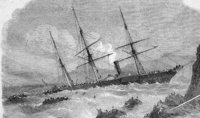Annotation:Nymrod Hornpipe
Back to Nymrod Hornpipe
NYMROD HORNPIPE. AKA - "Nimrod Hornpipe." American, Hornpipe. B Flat Major. Standard tuning (fiddle). AABB. Composition credited to one G.L. Tracy in Ryan's Mammoth Collection (1883). George Lowell Tracy (1855-1921) was a young man who later composed light opera and composition books, according to musicologist Charles Wolfe. Evidently Tracy arranged music as well, for one publication from the 1880's indicates an Arthur & Sullivan work was arranged by him. Al Smitley suggests the tune may have been named for the ship Nimrod, a name that appears in American Clipper Ships 1833-1858 by Howe and Matthews. There have been several ships named Nimrod (which means 'great huntsman'), including a British warship, H.M.S. Nimrod, an 18 gun, 100-foot-long brig whose duty it was in the War of 1812 to patrol the coastal waters of Cape Cod, Rhode Island and Connecticut, enforcing the British blockade of American shipping. On January 14, 1814, the Nimrod, commanded by Nathaniel Mitchell, Esq., bombarded Falmouth, Massachusetts on Cape Cod from noon until evening. No one was injured during the attack, but many houses in the vicinity of Shore and Main Street were damaged. On June 13, 1814, Nimrod trapped and burned Falmouth's fleet in Wareham Harbor where 17 ships had taken refuge. The next day the brig went aground in Buzzards Bay. The high tide was not sufficient to free the brig, so in an act of desperation the crew lightened the Nimrod by dropping some of her armament overboard. The lighter ship was then floated free, and the British escaped before being captured by American militiamen. Years later, divers discovered the abandoned cannons and they were raised from the depths.
The tune in Ryan's/Cole's may have been named for another vessel, however. This Nimrod was built in Liverpool in 1843 for the Cork Steamship Company and was a 177 foot-long, 583 ton, paddle steamer with a three-masted schooner rig to augment the engine. It is chiefly remembered for the tragedy of its demise, a sensation in its day and widely reported. On the night of February 27th, 1860, just off St. David's Head, Pembrokeshire, Dyfed, the Nimrod was observed by another ship to have set its sails and that her engines had stopped. Upon being hailed and asked if he needed help, the Captain of the Nimrod, a Scotsman named Lyall, asked the price of a tow but could not agree to the terms offered. Since the seas were moderate he believed he could make it back to port under sail. Unfortunately, as the night wore on the winds picked up, the weather worsened dramatically, and the Nimrod could make no headway. Finally, it was driven onto the cliffs of St. David's Head, and was dashed to pieces with the loss of life of all aboard, 45 souls. Despite spying the ship in imminent distress, there was nothing the local inhabitants could do as there was no way down the 100-foot cliff. They could only watch in horror as they listened to the cries for help of the drowning people. It was reported that Captain Lyall was last seen clutching the stern rail with his head in his hands.

Among the passengers that drowned was a woman who happened to be on board because of a somewhat odd occurrence the previous week. Her husband was Captain Wigham, of the schooner Wendlydale which was bound for Bremen with log wood when he became insane on the Atlantic crossing. The schooner put into Cobh, Ireland, where the ship's agents put him into lodgings. The owners contacted his wife in Newcastle and she traveled to Liverpool only just in time to catch the Nimrod as it was leaving the quay. The unfortunate woman never arrived in Ireland to nurse her poor husband.
Source for notated version: Mark O'Connor [Phillips].
Printed sources: Cole (1000 Fiddle Tunes), 1940; p. 97. Phillips (Traditional American Fiddle Tunes, vol. 2), 1995; p. 211. Ryan's Mammoth Collection, 1883; p. 132.
Recorded sources:
See also listing at:
Hear fiddler Vi Wickham play the tune on youtube.com [1]
